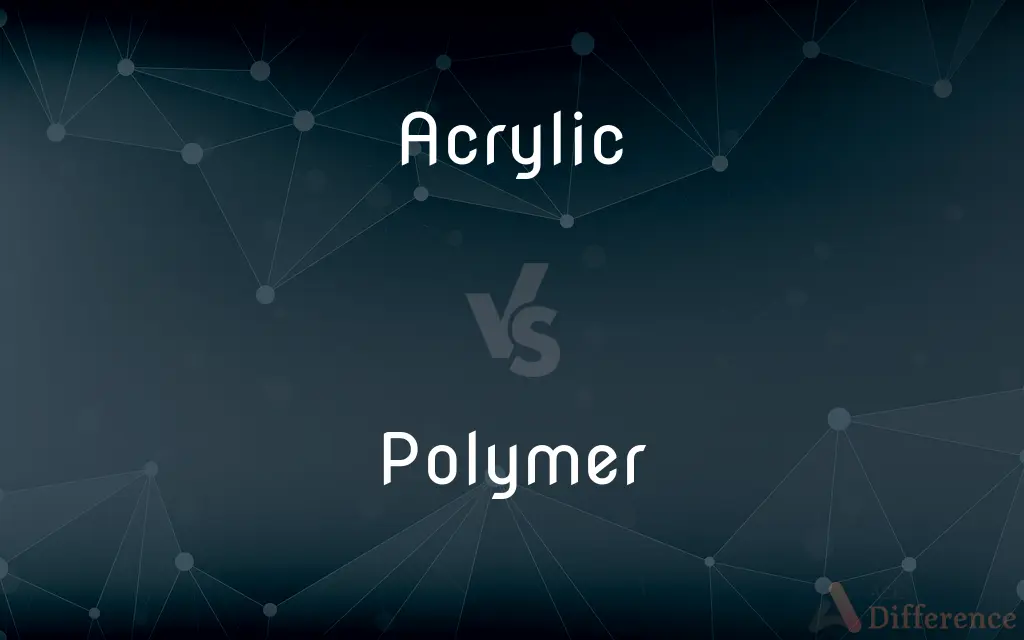Acrylic vs. Polymer — What's the Difference?
By Tayyaba Rehman — Updated on October 27, 2023
Acrylic refers to synthetic fibers or resins derived from acrylic acid, while Polymer is a general term for large molecules comprising repeated subunits.

Difference Between Acrylic and Polymer
Table of Contents
ADVERTISEMENT
Key Differences
Acrylic is a type of plastic material that's specifically derived from acrylic acid, offering clarity, brilliance, and weather resistance. Polymer, on the other hand, encompasses a broader range of large molecules made up of repeating chemical units. Essentially, Acrylic is a specific type of Polymer.
While both terms can be related to the world of plastics, Acrylic points to a distinct subset that's particularly known for its glass-like appearance and sturdiness. Polymer, in its broadest sense, covers a wide array of materials including natural compounds like DNA and synthetic ones like nylon or polyethylene.
Every Acrylic is a Polymer, but not every Polymer is an Acrylic.
Comparison Chart
Definition
A plastic material derived from acrylic acid.
Large molecules made up of repeated chemical units.
Scope
Specific type of polymer.
Broad category including many materials.
ADVERTISEMENT
Origin
Derived from acrylic acid.
Can be natural or synthetic.
Examples
Plexiglass, acrylic paints.
DNA, nylon, polyethylene, acrylic.
Primary Use
Used for its clarity and weather resistance.
Used in a wide range of products and applications.
Compare with Definitions
Acrylic
A synthetic fiber used in textiles.
Her sweater was made of soft Acrylic yarn.
Polymer
Large molecules made of repeated subunits.
DNA is a natural Polymer essential for life.
Acrylic
A synthetic material with a glass-like clarity.
Acrylic sheets are often used as an alternative to glass.
Polymer
Can be natural or synthetic.
Rubber is a natural Polymer, while nylon is synthetic.
Acrylic
A type of polymer known for its transparency.
Acrylic aquariums offer a clear view of the marine life inside.
Polymer
Used widely in the plastics industry.
Many household containers are made of Polymer materials.
Acrylic
Often used in crafting and DIY projects.
She used Acrylic beads for her jewelry-making project.
Polymer
Exhibits varied properties based on structure.
The Polymer's flexibility depends on its molecular arrangement.
Acrylic
(of synthetic resins and textile fibres) made from polymers of acrylic acid or acrylates
A red acrylic jumper
Polymer
Essential in modern manufacturing.
The automotive industry relies on various Polymers for car components.
Acrylic
An acrylic textile fibre
A sweater in four-ply acrylic
Polymer
A polymer (; Greek poly-, "many" + -mer, "part") is a substance or material consisting of very large molecules, or macromolecules, composed of many repeating subunits. Due to their broad spectrum of properties, both synthetic and natural polymers play essential and ubiquitous roles in everyday life.
Acrylic
An acrylic paint
Washes of white acrylic
She paints mainly in acrylics
Polymer
Any of numerous natural and synthetic compounds of usually high molecular weight consisting of up to millions of repeated linked units, each a relatively light and simple molecule.
Acrylic
An acrylic resin.
Polymer
(organic chemistry) A long or larger molecule consisting of a chain or network of many repeating units, formed by chemically bonding together many identical or similar small molecules called monomers. A polymer is formed by polymerization, the joining of many monomer molecules.
Acrylic
A paint containing acrylic resin.
Polymer
A material consisting of such polymer molecules.
Acrylic
A painting done in acrylic resin.
Polymer
Any one of two or more substances related to each other by polymerism; specifically, a substance produced from another substance by chemical polymerization.
Acrylic
Any of numerous synthetic fibers polymerized from acrylonitrile.
Polymer
A naturally occurring or synthetic compound consisting of large molecules made up of a linked series of repeated simple monomers
Acrylic
(organic chemistry) Derived from acrylic acid or acrylonitrile.
Acrylic
Containing an acrylic resin.
Acrylic
(organic chemistry) An acrylic resin.
Acrylic
(painting) A paint containing an acrylic resin.
When it comes to painting, I prefer using acrylics as my medium.
Acrylic
A painting executed using such a paint.
Acrylic
A thick sheet of plastic.
Acrylic
A liquid coating system based on an acrylic resin.
Acrylic
Of or containing acryl, the hypothetical radical of which acrolein is the hydride; as, acrylic acid. The characteristic residue in an acrylic compound is the carbonyl group attached directly to an ethylenic carbon.
Acrylic
Same as acrylic resin.
Acrylic
Same as acrylic fiber.
Acrylic
A paint in which the pigment is suspended in a solution of an acrylic resin, which dries to a hard film on exposure to air.
Acrylic
A painting made using an acrylic paint.
Acrylic
Polymerized from acrylonitrile
Acrylic
A glassy thermoplastic; can be cast and molded or used in coatings and adhesives
Acrylic
Used especially by artists
Acrylic
A synthetic fabric
Acrylic
A resin derived from acrylic acid.
The artist chose Acrylic paints for their vivid colors.
Common Curiosities
Which is broader in scope, Acrylic or Polymer?
Polymer has a broader scope, encompassing a wide array of materials.
Can Acrylic be used in textiles?
Yes, Acrylic fibers are used in making textiles like sweaters and blankets.
How are Polymers formed?
Polymers are formed by the repeated linking of small chemical units called monomers.
Is every Polymer synthetic?
No, Polymers can be both natural, like DNA, and synthetic, like nylon.
Is Acrylic a type of Polymer?
Yes, Acrylic is a specific type of Polymer derived from acrylic acid.
Is Acrylic resistant to UV rays?
Yes, one of Acrylic's attributes is its resistance to UV radiation.
What is Acrylic best known for?
Acrylic is known for its clarity, brilliance, and resistance to weather.
Is Plexiglass the same as Acrylic?
Yes, Plexiglass is a brand name for Acrylic sheeting.
Can Polymers be broken down?
Yes, but the rate and method differ. Some Polymers are biodegradable, while others are more resistant to degradation.
How are Polymers used in daily life?
Polymers are found in everyday items, from plastic bottles to toys to car parts.
Are Acrylic paints water-based?
Typically, yes. Acrylic paints are water-soluble but become water-resistant when dry.
What makes Polymers unique?
The properties of a Polymer vary based on its structure and the monomers used.
Do all Polymers have the same properties?
No, different Polymers have varying properties, from flexibility to strength, based on their molecular structures.
How durable is Acrylic?
Acrylic is durable, with good resistance to impact and the elements.
Is Acrylic safe for crafting with kids?
Yes, Acrylic materials, like beads or paints, are generally safe for crafting, but always follow product guidelines.
Share Your Discovery

Previous Comparison
Ice vs. Slush
Next Comparison
Satire vs. ParodyAuthor Spotlight
Written by
Tayyaba RehmanTayyaba Rehman is a distinguished writer, currently serving as a primary contributor to askdifference.com. As a researcher in semantics and etymology, Tayyaba's passion for the complexity of languages and their distinctions has found a perfect home on the platform. Tayyaba delves into the intricacies of language, distinguishing between commonly confused words and phrases, thereby providing clarity for readers worldwide.















































